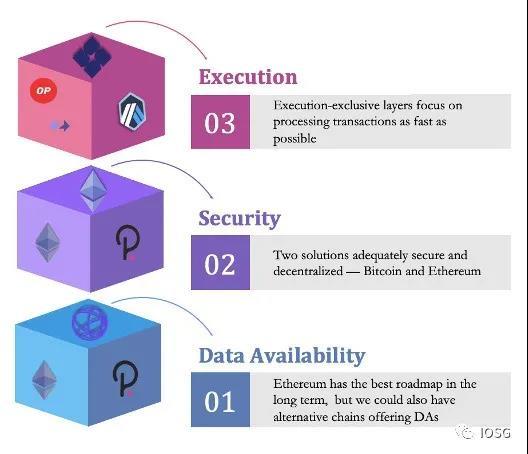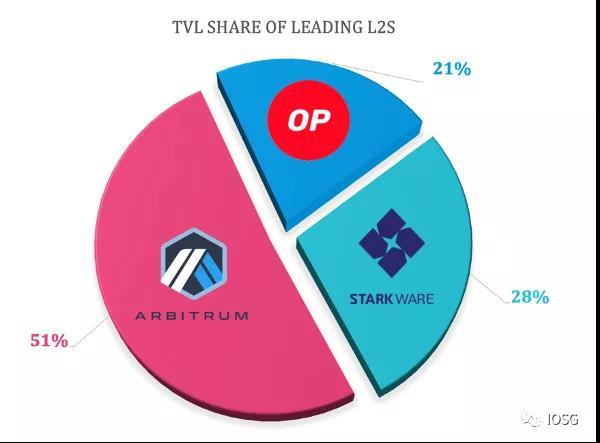IOSG Ventures: An In-Depth Look at Innovations in Modular Blockchains and Scaling Execution Layers
Author: IOSG Ventures
Understanding ZK Rollups and Optimistic Rollups in Simple Terms
First, let's talk about Layer 2. Layer 2 actually does not have the concept of blocks, nor does it have nodes or require a consensus mechanism, so you won't see blocks on the block explorer for Layer 2 solutions. The operators of Layer 2 are only responsible for ordering transactions and then processing them. The key aspect of Layer 2 networks lies in the work of transaction ordering.
In 2021, we witnessed the rise of the Layer 2 market and the emergence of more liquidity/projects. Currently, there are over 19 Layer 2 solutions for general or specific applications on Ethereum. Among them, StarkWare and ZkSync lead in ZK Rollups, achieving scalability through zero-knowledge proofs. Arbitrum and Optimism are leading projects in Optimistic Rollups.
The leading ZK chain StarkWare has a TVL of $1.2B and has processed over 55 million transactions. Projects utilizing StarkEx technology include well-known hits like dYdX, ImmutableX, DeversiFi, and Sorare. In the OP space, Arbitrum has processed over three million transactions, with a TVL exceeding that of Optimism by more than double, reaching $2.25B (while Optimism has only processed over 200,000 transactions, with a TVL of $1.1B). At the same time, we cannot ignore projects making progress in cross-chain liquidity, such as Celer, Hop Protocol, and Connext.
 Source: IOSG 2021 Summit
Source: IOSG 2021 Summit
In simple terms, we can categorize the differences between the two Layer 2 (ZK and OP) solutions as follows:
ZK sends a small portion of encrypted data containing the result and proof of the result to the mainnet to prove that the result is correct; OP also sends the result and the original records to the mainnet, where evidence can be checked if there is a challenge.
As Layer 2 infrastructure matures, we can foresee a richer ecosystem for Layer 2. We expect that in the coming year, over 80% of the traffic on Layer 1 main chains will migrate to Layer 2; this is just the beginning of the great migration to Layer 2.
Three Layers of Modular Blockchain

Source: IOSG 2021 Summit
The concept of Modular Blockchain provides a better solution for the "impossible triangle" of scalability. By separating the execution layer, security layer, and data availability layer, the Ethereum main chain will offer better underlying compatibility design, while innovative L2 execution layers will provide higher TPS and lower fees.
In simple terms, a blockchain has three responsibilities: execution, security, and data availability. For a long time, these responsibilities have been handled by a single blockchain, which has led to scalability issues. Under the concept of modular blockchain, the execution layer, security layer, and data availability layer will be separated.
In the concept of Modular blockchain, Execution, Security, and DA are independently separated, with the development of the Execution layer being the most notable in 2021. In terms of Security, due to competitive difficulty, this layer is limited to BTC/ETH/Polkadot. Moreover, BTC has no plans to compete with ETH in the short term. In terms of DA, ETH still leads, mainly due to the large amount of data availability brought by numerous shard chains. We also cannot overlook potential DA chains. As ETH 2.0 develops, when more data availability is provided to Rollups, the TPS of the main chain will significantly increase, and fees will decrease.
Looking at the three layers separately, from the perspective of the security layer, BTC and ETH are the only two chains that aim for decentralization from the node level. The security layer is the most important because anti-censorship and the degree of decentralization are the most crucial qualities of a chain. Currently, BTC has no plans to provide higher data availability than ETH in the short term, so Ethereum remains the primary provider of Layer 2 security.
In terms of data availability, a sufficient number of blocks is needed to ensure the possibility of more data storage. ETH currently leads because of its shard chain plan, which can provide sufficient data availability for Layer 2. However, competitors like Celestia, Polygon, Near, and Tezos also have similar plans as ETH. As ETH 2.0 develops (a term recently abandoned by the Ethereum Foundation), when more data availability is provided to the rollup process, the TPS of the main chain will significantly increase, and fees will decrease.
Finally, transactions and smart contracts occur at the execution layer. All smart contracts, dApps, and users interact at the execution layer. The execution layer should focus on processing as many execution processes as possible while outsourcing security and data availability to projects. Current Layer 2 solutions, such as Arbitrum, Optimism, StarkWare, and ZkSync, are focusing on developing more efficient execution layers.
Current Overview of the Execution Layer

Layer 2 soared in 2021

Source: IOSG 2021 Summit
Although Layer 2 has only been online for a few months, their TVL has already reached $7 billion. Among existing Layer 2s, Arbitrum has the highest TVL. Because Arbitrum has EVM compatibility, developers find it easier to deploy applications on it. Binance recently announced support for depositing and withdrawing funds on Arbitrum Layer 2, which will greatly increase the usage of Arbitrum Layer 2. Meanwhile, ZK Rollups (StarkWare) has had more transaction volume in the past seven days, showing a stronger scalability advantage compared to Optimistic Rollups. Additionally, most DeFi applications, such as Uniswap and Sushiswap, have already begun deploying on L2.
Some applications on Layer 2, like dYdX, have achieved TPS performance comparable to CEX and L1 applications. In the two months following its launch, dYdX had days with more trading volume than the combined volume of Coinbase and Uniswap! This shows that Layer 2 indeed has immense potential.
One controversial point about Layer 2 is transaction fees. Layer 2 transaction fees are not necessarily cheaper than Layer 1, but after developers optimize the network, Layer 2 fees should be much lower than they are now. The competitive advantage of Layer 2 in transaction fees will gradually become apparent. Currently, Layer 2 transaction fees are at least 10 times lower than L1 transaction fees. In the future, each transaction fee may even be below $0.1. We will see that in the near future, Ethereum Layer 2 will not only have transaction fees below $0.1 but will also capture a larger market share than Layer 1 solutions like BSC and Polygon. Therefore, in the next 3-5 years, we hope that most applications and users will migrate to Layer 2.
Who’s Next? Layer 3 To Da Moon!

Source: IOSG Ventures
If you think Layer 2 is the best solution for scalability, you are mistaken! Although Layer 2 can scale and reduce the cost of each transaction, some applications still require more customized services that better meet their needs. Layer 2 maintains its advantages in decentralization and other universal purposes, but Layer 3 will further enhance application efficiency.
Layer 3 to Layer 2 is like Layer 2 to Layer 1. Layer 3 will publish validity proofs on Layer 2, just as Layer 2 executes batch transactions and publishes validity proofs on Layer 1. When Layer 2 can support verifying validator smart contracts (for example, after StarkWare releases StarkNet), this multi-packaging structure can increase the data utilization of validity proofs. In addition to scalability, Layer 3 will also have more development directions, such as privacy. In this case, validity proofs will be replaced by zero-knowledge proofs.
Conclusion
We have been closely monitoring the development of the Layer 2 space in recent years. We are excited to collaborate with many leading L2 projects, such as Arbitrum for Optimistic Rollups, StarkWare for ZK Rollups, and Celer for cross-chain bridge liquidity solutions.
We believe that in the near future, Layer 2 networks will become more competitive than Layer 1 in terms of transaction fees/TPS.
In addition to general Layer 2, customized Layer 2 and Layer 3 will further expand the blockchain, such as infrastructure provider StarkWare developing SaaS business.
At the infrastructure level, there are also some enticing investment opportunities in new technologies, such as Celestia in the data availability space and Movr in the cross-chain liquidity transfer space, both of which are excellent examples.
We also hope to see significant innovations on the application side, driven by Layer 2 technology in new application designs. The characteristics of Layer 2, such as scalability and privacy, will undoubtedly bring more innovation in dApp design!










